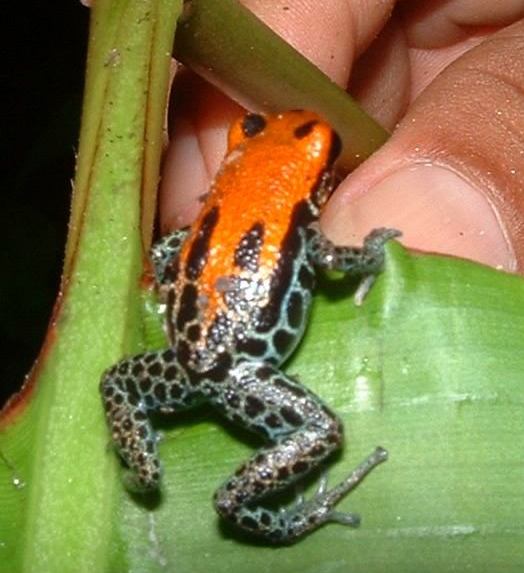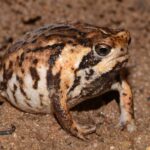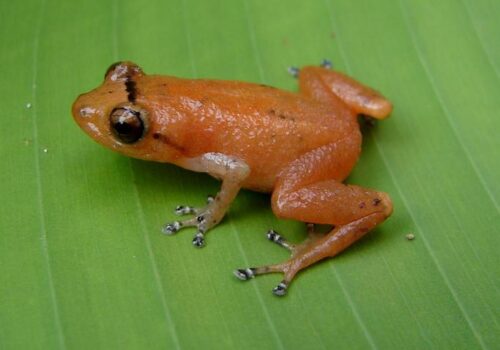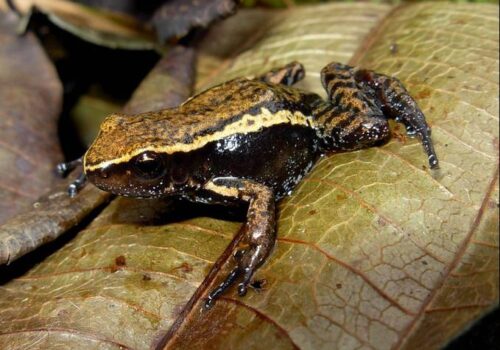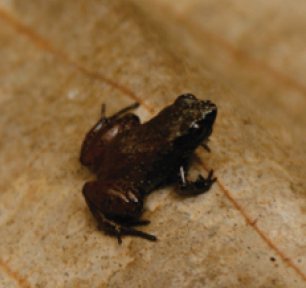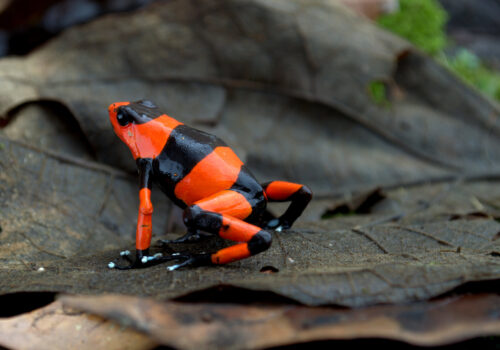- Introduction: Meeting the Jewel of Amazonia
- Taxonomy and Classification
- Natural Habitat: A World Elevated in Green
- Physical Characteristics: A Dazzling Ensemble
- Behavior and Life Cycle: Caring Parents and Renewed Life
- Ecological Role: Web of Connections
- Threats and Conservation Status: Fragile Existence in a Changing World
- Cultural and Scientific Significance: Nature's Chemical Innovators
- Conclusion: Protecting Homelands of the Reticulated Dart Frog
Introduction: Meeting the Jewel of Amazonia#
Deep within the lush embrace of the Peruvian Amazon lies an exquisite gem, sparkling amidst the greenery like a tiny jewel— a frog whose brilliance belies its miniature stature. This marvel of evolution is Ranitomeya reticulata, more affectionately known by enthusiasts as the Reticulated Poison Dart Frog. With a body barely larger than a human fingertip, adorned in vivid hues of fiery red, precise geometric black markings, and dappled blue legs, it’s an embodiment of nature’s lavish palette.
Yet, this creature’s beauty harbors nature’s fascinating paradox—boundless charisma paired with potent, defensive poison compelling predators to tread carefully. Often unnoticed amidst broader conservation narratives, Ranitomeya reticulata serves not merely as an enigmatic forest dweller but as an essential link in the intricate web of Amazonian biodiversity.
Taxonomy and Classification#
Ranitomeya reticulata belongs within the order Anura, class Amphibia—frogs and toads. Further classified in the family Dendrobatidae, this family is renowned worldwide as “Poison Dart Frogs,” known for their astonishing colors and potent skin toxins. Within this family, a myriad of vibrant frog species populate Central and South America’s lush rainforests, each evolving unique colorations and toxins to survive diverse ecological niches.
The genus Ranitomeya, specifically, distinguishes itself from other Dendrobatidae genera with uniquely petite body sizes, arboreal habits, and intricate parental behaviors. Among its closest relatives are other visually mesmerizing species—like Ranitomeya imitator and Ranitomeya fantastica—examples that underline the evolutionary creativity of this vibrant genus.
Natural Habitat: A World Elevated in Green#
The vivid habitats of Ranitomeya reticulata frequently evoke mystery and wonder, hidden as they are within secondary forests, dense tropical rainforests, and transitional zones across eastern Peru and parts of western Brazil. Here, sunlight trickles down in patches through dense leaf canopies, striking droplets of dew and refracting rainbows across lush foliage.
Vertical Living Spaces#
Unlike many frog species that prefer damp forest floors, Ranitomeya reticulata has adapted remarkably to an arboreal life, often residing several meters above ground. The warm, humid microclimate found within bromeliads forms the heart of this frog’s universe—each cup-shaped plant serving as home, nursery, and hunting ground. Here, amidst pockets of captured water, small insects thrive, providing nourishment and fueling this tiny predator’s vibrant life.
This adoption of arboreal habitat not only safeguards it from ground-level predators but allows this colorful amphibian to maintain a sheltered micro-world, away from the harsher climates and larger predators below.
Physical Characteristics: A Dazzling Ensemble#
When encountering Ranitomeya reticulata, observers first notice its astonishingly precise patterning: a vivid red-orange head that transitions seamlessly into elaborate geometric patterns of stark black netting, giving rise to its common name “Reticulated Dart Frog.” The body’s dorsal side exhibits highly contrasted reticulations—black lines weaving meticulously over a brilliant orange-red backdrop. The legs, painted blue-black, contrast elegantly with the body, reminiscent of carefully placed brushstrokes.
Rarely exceeding 20 mm (0.8 inches) in size, the tiny stature of this frog belies its significant ecological role. Their compact build and strong adhesive toe-pads adapt perfectly for a life spent traversing leafy vertical surfaces, often looped precariously above the forest floor, where life flourishes precariously yet vibrantly.
Toxic Beauty as Defense#
This dazzling coloration signifies a biological phenomenon termed “aposematism,” a vivid warning of the potent toxins harbored within its skin. This chemically fortified defense mechanism—a potent alkaloid capable of severely disrupting a predator’s physiological processes—acts as an effective deterrent against predation. Not innate at birth, these toxins are sequestered from prey items, primarily ants and mites, consumed throughout their lifespan. Such chemical assimilation neatly illustrates the intimate connectivity of rainforest food webs.
Behavior and Life Cycle: Caring Parents and Renewed Life#
Ranitomeya reticulata lives largely concealed from plain view and spends its life navigating the fluid labyrinth of vine-entwined vegetation. Timid and reclusive by nature, it rarely ventures farther than a few meters from its chosen bromeliad refuge.
Dietary Preferences#
Primarily insectivorous, this minute ambush predator specializes in small forest insects, targeting ants, mites, springtails, and other minute arthropods. Its hunting technique involves stealth and patience, waiting quietly amidst foliage, swiftly seizing unsuspecting prey during precise leaps.
Intricate Reproductive Behaviors#
The reproductive cycle of Ranitomeya reticulata offers a stunning glimpse into the complexity of amphibian parental care. Male frogs carefully engage in elaborate vocal courtship displays, badges of fitness displayed loudly within the rainforest concert. Once convinced, females deposit a handful of eggs within protective pools constructed within bromeliads—hidden nurseries suspended above ground.
Yet parental duties do not end with egg deposition. After hatching, males perform a remarkable act—transporting developing tadpoles individually upon their backs to various water-filled bromeliad leaves, painstakingly ensuring each offspring possesses its private nursery. Subsequently, female frogs visit tadpoles periodically, laying unfertilized “trophic” eggs that serve as nutrition, carefully nurturing the next generation amid the rainforest’s vibrant leaf architecture.
Ecological Role: Web of Connections#
Despite their elusiveness, these dart frogs carve fundamental niches within rainforest synchrony. Situated within a dense web of life, they regulate insect populations critical for forest health and provide sustenance for certain specialized predators tolerant to their toxins. Moreover, their brightly colored, toxin-laden bodies signal an essential ecological indicator role—populations responding quickly to environmental disruptions, thereby acting as sentinels of Amazonian ecosystem integrity.
Threats and Conservation Status: Fragile Existence in a Changing World#
Although formally categorized as “Least Concern” by the International Union for Conservation of Nature (IUCN), the ornate biological tapestry hosting Ranitomeya reticulata faces increasingly severe anthropogenic threats. Habitat loss, driven by deforestation and land conversion for agriculture, steadily encroaches upon its specialized habitat niches.
Illegal collection for the exotic pet trade further compounds pressures on localized populations. Despite international regulations under CITES controlling trade, clandestine collections continue, exploiting their vivid attractiveness and rarity. Initiatives aiming to balance community livelihoods with biodiversity protection alongside captive breeding programs represent vital strategies aimed to preserve this jewel-like species against mounting challenges.
Cultural and Scientific Significance: Nature’s Chemical Innovators#
Indigenous communities living alongside these frogs have long revered them; some tribes historically utilized related species’ neurotoxins to coat blowgun darts for hunting—though typically, smaller frogs like Ranitomeya reticulata played less significant roles. Yet beyond cultural intrigue lies immense scientific potential. Research into dendrobatid alkaloids has yielded novel insights into pharmaceuticals, notably regarding anesthetics, pain relief, and other medicinal breakthroughs.
Conclusion: Protecting Homelands of the Reticulated Dart Frog#
The unique existence of Ranitomeya reticulata, steeped in marvel and biological complexity, requires our attention and respect. Every glimpse into its secretive world, from striking coloration to intricate parental strategies, reflects evolutionary innovation carefully shaped by an ancient rainforest habitat. Conserving their homes translates to protecting immense biological wealth still nestled within Amazonian rainforests.
As nature enthusiasts and conservationists alike, we shoulder a communal responsibility toward ensuring that this tiny amphibious masterpiece thrives into perpetuity. The beautiful reticulated dart frog serves as a vital reminder—that sometimes nature’s smallest creatures offer the most profound lessons.






